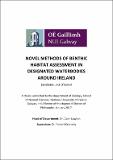| dc.contributor.advisor | Kennedy, Robert | |
| dc.contributor.author | O'Carroll, Jack | |
| dc.date.accessioned | 2017-05-12T07:59:36Z | |
| dc.date.available | 2017-05-12T07:59:36Z | |
| dc.date.issued | 2017-01-06 | |
| dc.identifier.uri | http://hdl.handle.net/10379/6514 | |
| dc.description.abstract | The European Union has implemented some of the most progressive conservation Directives in the world. These Directives are implemented in different ways, have different reporting cycles and use unique terminologies. The objectives of all the Directives require that the ecosystem based approach be applied when assessing the ‘status’ of the benthic environment. Benthic ecologists are faced with particular challenges when addressing the requirements of these Directives.
Some anthropogenic activities in designated waterbodies can be difficult to monitor due to the variable nature of the environment in which they occur. Some of the newest forms of anthropogenic activities in the coastal environment may have significant impacts on local hydrographic regimes. This will require the relationship between the benthos and modified hydrodynamic conditions to be assessed. Large scale predictive models will be required to form baseline datasets for benthic communities within Ireland’s Exclusive Economic Zone (EEZ). Large scale mapping initiatives such as these are financially costly and it is important for benthic ecologists to understand the effectiveness of the available tools and resources prior to carrying out such studies.
This thesis presents some new methods of benthic habitat assessment which can help to circumvent some of the key issues facing benthic ecologists working in response to EU Directives. We assess the effects of intertidal bivalve trestle cultivation on important bird feeding grounds in Natura 2000 sites. We present the Ecological Quality Ratio (EQR) Infaunal Quality Index (IQI) as an effective tool for assessing the risk posed to the conservation status of these sites.
The potential effects of tidal energy extraction on epibenthic reef communities in a Natura 2000 site are assessed. Case studies are presented that assess the spatial and temporal effects of tidal turbine installation and operation. The relationship between epibenthic communities and a range of current velocities required to produce rated tidal energy are assessed. The turbulent wake of a tidal energy turbine was simulated and the relationship between epibenthic community structure and the simulated modified wake is assessed. We present the High Energy Hard Substrate (HEHS) index, a new EQR that was developed for use in animal-dominated, stable reefs, as an effective monitoring tool within tidal energy extraction sites.
The effectiveness of hydrodynamic modelling and acoustically classified sediment data, as predictors of benthic biotopes was assessed using Galway Bay as a case study. This approach has potential application in mapping Irelands EEZ for the purposes of the Marine Strategy Framework Directive (MSFD). | en_IE |
| dc.rights | Attribution-NonCommercial-NoDerivs 3.0 Ireland | |
| dc.rights.uri | https://creativecommons.org/licenses/by-nc-nd/3.0/ie/ | |
| dc.subject | Natural sciences | en_IE |
| dc.subject | Zoology | en_IE |
| dc.subject | Benthic habitat | en_IE |
| dc.subject | Ireland | en_IE |
| dc.subject | Waterbodies | en_IE |
| dc.title | Novel methods of benthic habitat assessment in designated waterbodies around Ireland | en_IE |
| dc.type | Thesis | en_IE |
| dc.contributor.funder | Griffith Geoscience Award (partly) | en_IE |
| dc.local.final | Yes | en_IE |
| nui.item.downloads | 910 | |


